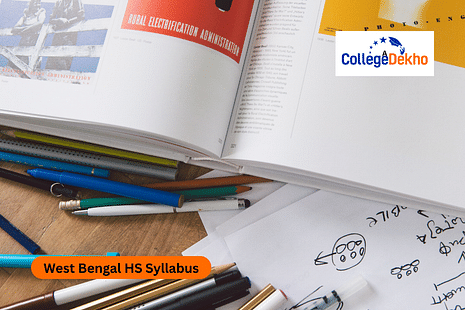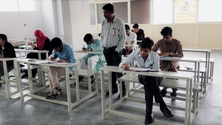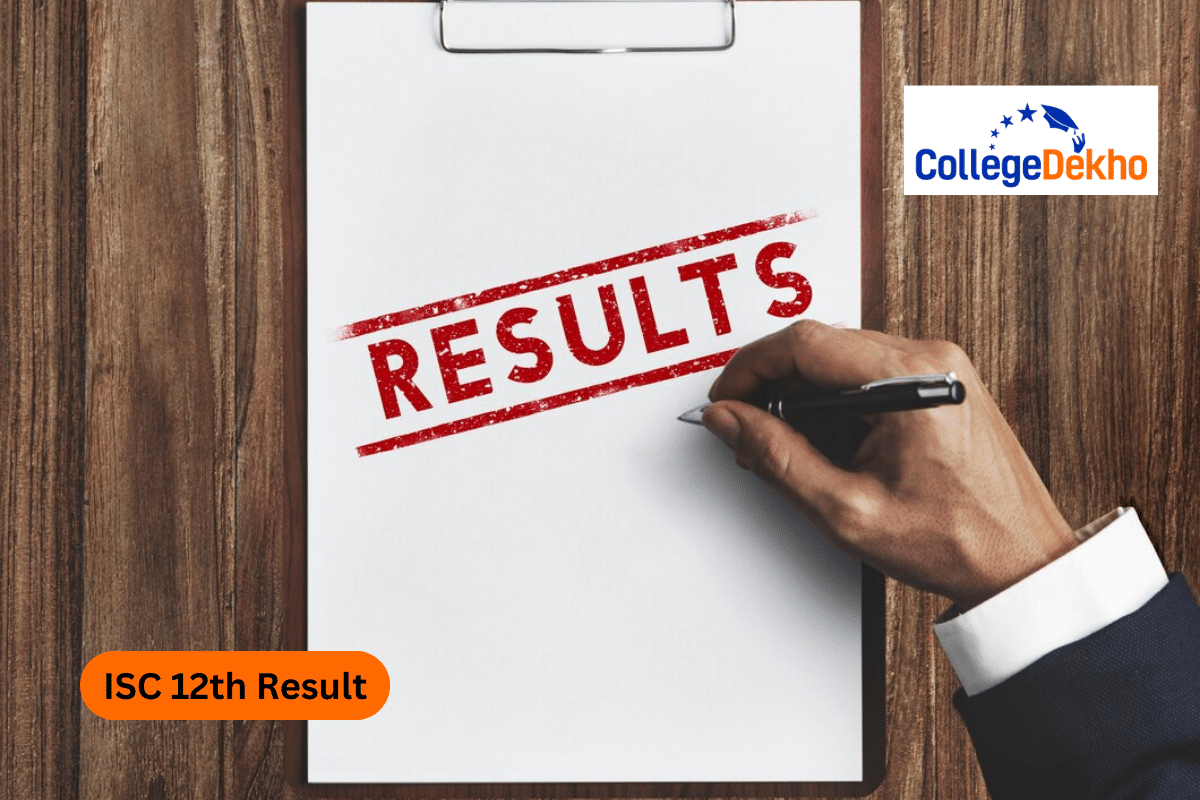West Bengal HS Syllabus 2024-25 is now revised and provided online. Check the details and download the PDF of the syllabus to start your preparations today.
- About West Bengal HS Syllabus 2024-25
- West Bengal HS Syllabus 2024-25: Download PDF
- WBCHSE Syllabus 2025 for Mathematics
- WBCHSE Syllabus 2025 for Physics
- WBCHSE Syllabus 2025 for Chemistry
- WBCHSE Syllabus 2024-25 for Languages
- WBCHSE Syllabus 2024-25 for Biological Sciences
- WBCHSE Syllabus 2024-25 for Accountancy
- Benefits of Knowing the West Bengal HS Syllabus 2024-25
- West Bengal HS Syllabus 2024-25: Preparation Tips
- Faqs


Never Miss an Exam Update
About West Bengal HS Syllabus 2024-25
The West Bengal board follows a set West Bengal HS syllabus for all subjects. The students going to prepare for the West Bengal exams 2025 should go through the syllabus in detail. The students should prepare for the subjects through the revised syllabus. In this article, students can check the units and topics included in each subject. In addition, they can also know the marks allotted to each topic. This will help in preparing the syllabus.
The students can divide the syllabus in different parts and aim at completing the syllabus in advance. The students can pay more attention to the topics with the high marks. Ensure that no topic is left for preparation. Carefully read the article in detail to understand the syllabus.
Also Read:
WB Board Class 12 Exam Pattern 2024-25
West Bengal HS Syllabus 2024-25: Download PDF
Having a PDF or a printout of the syllabus is a must-have while preparing for the exam. It helps you to get rid of your confusion and make the curriculum easily accessible. Check the direct PDFs of the syllabus from the table given below:
| Subjects | Download Link |
|---|---|
| Hindi | Download PDF |
| English | Download PDF |
| Physics | Download PDF |
| Mathematics | Download PDF |
| Chemistry | Download PDF |
| Biological Science | Download PDF |
| Accountancy | Download PDF |
| Business Studies | Download PDF |
| Political Science | Download PDF |
| Philosophy | Download PDF |
| Sociology | Download PDF |
| Economics | Download PDF |
| History | Download PDF |
| Psychology | Download PDF |
| Geography | Download PDF |
WBCHSE Syllabus 2025 for Mathematics
Refer to the table below to know the units and topics included in the Mathematics syllabus. Also, check the marks allotted to the topics.
Units | Topics | Marks |
|---|---|---|
Relations and Functions |
| 8 |
Algebra |
| 11 |
Calculus |
| 36 |
Vectors and Three-Dimensional Geometry |
| 13 |
Linear Programming |
| 4 |
Probability |
| 8 |
Total | 80 | |
WBCHSE Syllabus 2025 for Physics
Go through the table below to know the topics included in the syllabus and the marks allotted to them.
Units | Marks |
|---|---|
Electrostatics | 8 |
Current Electricity | 8 |
Calculus | 8 |
Electromagnetic Induction and Alternating Current | 8 |
Electromagnetic Waves | 3 |
Optics | 14 |
Dual Nature of Radiation and Matter | 4 |
Atoms and Nuclei | 6 |
Electronic Devices | 8 |
Communication System | 3 |
Total | 70 |
WBCHSE Syllabus 2025 for Chemistry
Check the names of units and marks allotted to each of them. Prepare the study plan accordingly and solve all questions efficiently.
Units | Marks |
|---|---|
Solid State | 4 |
Solutions | 5 |
Electrochemistry | 5 |
Chemical Kinetics | 5 |
Surface Chemistry | 4 |
General principles and processes of Isolation of Elements | 3 |
p-Block Elements | 8 |
d-and f- Block Elements | 5 |
Coordination Compounds | 3 |
Haloalkanes and Haloarenes | 4 |
Alcohols, Phenols and Ethers | 4 |
Aldehydes, Ketones and Carboxylic acids | 6 |
Organic Compounds containing Nitrogen | 4 |
Bio molecules | 4 |
Polymers | 3 |
Chemistry in Everyday Life | 3 |
Total | 70 |
WBCHSE Syllabus 2024-25 for Languages
Students can check the Class 12 syllabus West Bengal board for languages. They can prepare a study plan and prepare the syllabus accordingly.
Subjects | Topics |
|---|---|
English (A) |
|
English (B) |
|
Santali |
|
Telugu | Poetry
Prose
Language :
Drama - 10 marks Essay ( Kanuparti varalaxma) - 10 marks Non Detailed Text ( Telugu Literature ) - 10 marks Project Work |
Urdu | Prose- 20 Marks Poetry- 20 marks Drama- 10 marks Rapid Reader- 10 marks History of Literature- 10 marks Grammar & Compositions - 10 marks Project - 20 marks |
WBCHSE Syllabus 2024-25 for Biological Sciences
Subjects | Topics | Marks |
|---|---|---|
Reproduction in Organisms |
| 14 |
Genetics and Evolution |
| 18 |
Biology and human welfare |
| 14 |
Biotechnology and its Applications | Biotechnology and its Application | 10 |
Ecology and the environment | Ecology Environment & Population Ecosystem Biodiversity And Conservation Environment Issues | 14 |
WBCHSE Syllabus 2024-25 for Accountancy
There will be three parts in the paper. Part A will be compulsory. Check the details below to understand the syllabus in detail.
Part A
- Introduction to partnership- 10 Marks
- Reconstruction of partnership- 25 Marks
- Accounting for shares capital - 20 marks
- Accounting for debentures - 5 marks
Part B
- Analysis of Financial Statements- 12 marks
- Cash Flow Statement- 8 marks
Part C
- Electronic Spread sheet , Use of Spread sheet , Graphs and Charts - 14 marks
- Database Management System of Accounting - 6 marks
- Project Work - 20 marks
Also Read: West Bengal HS Result 2025
Benefits of Knowing the West Bengal HS Syllabus 2024-25
- Focusing on the latest syllabus will help students to get a good knowledge of the chapters.
- During the revision of the syllabus, students will be able to get a good command of the subject.
- They will be able to write better answers. The students learn to write answers as per the marks.
- Familiarity with the exam pattern helps students to understand the types of questions asked in the board exam.
- An idea of marks enables students to prepare for the questions. They learn to write answers according to the marks allotted to the questions.
- By completing the syllabus in advance, students get sufficient time for revision.
West Bengal HS Syllabus 2024-25: Preparation Tips
Students preparing for the exam should read the preparation tips below to do well. A student can plan a timetable that includes enough time for all of the subjects on their syllabus as well as an extra hour for self-evaluation.- Go through the entire syllabus and divide it in smaller parts to cover up the syllabus easily.
- Make a schedule to complete the syllabus. Include little breaks in between.
- Candidates should also solve sample papers and previous year's question papers for revision.
- Make notes for all important topics. Revise the important chapters regularly.
- Download previous year's question papers and solve questions.
FAQs
The students should complete the West Bengal HS syllabus 2025 at least twice before the board exams. They should revise the syllabus and solve the questions at regular intervals.
If students study with full dedication from the first day, they can not only complete the entire West Bengal HS Syllabus 2024-25 on time but also revise. This will help them to understand the syllabus better and solve all questions in the board exams.
Students can download the previous year's question papers from the official website to revise West Bengal HS Syllabus 2024-25. Through the question papers, they can check the important questions or the questions that commonly come in the exam and practice them. They can also focus on the marks distribution for each of the questions to know which topics are important.
The board released the West Bengal HS Syllabus 2024-25 on its official website, wbchse.wb.gov.in. for the students to download. Click on the Student option present on the menu bar to download the curriculum.
To finish the West Bengal HS Syllabus 2024-25, students must first prepare a list of all the chapters and topics covered in the syllabus, then create a proper timetable and split their time into small batches, giving more attention to the weaker topics and their review.
Was this article helpful?
























